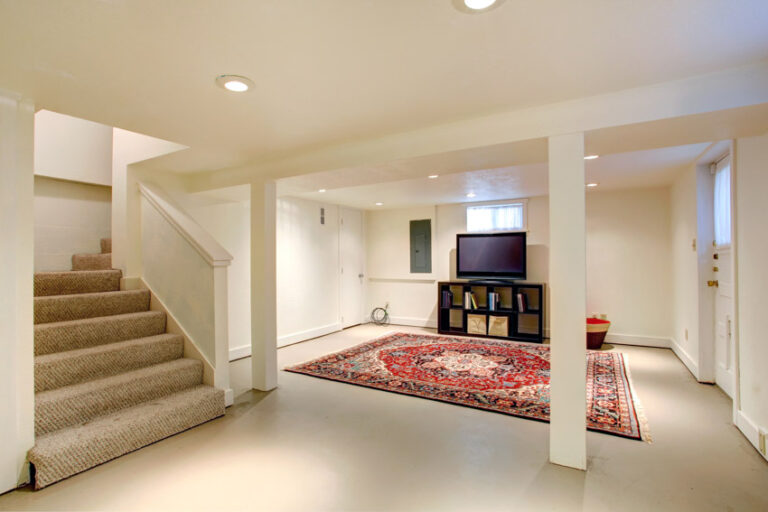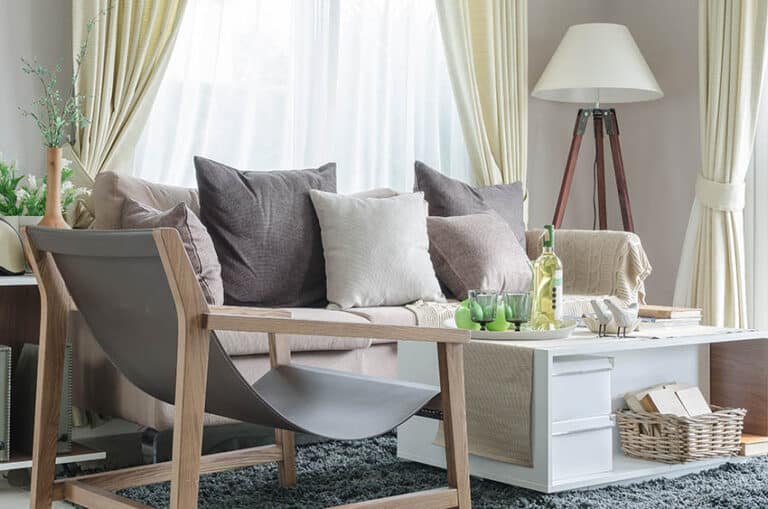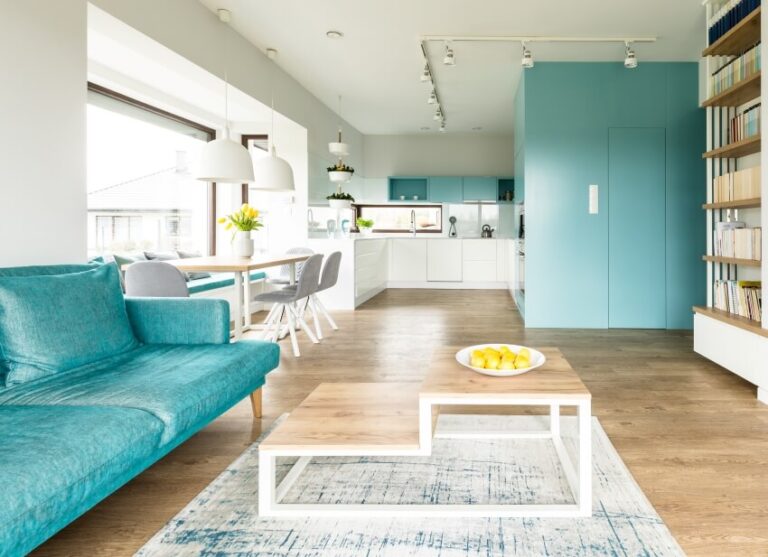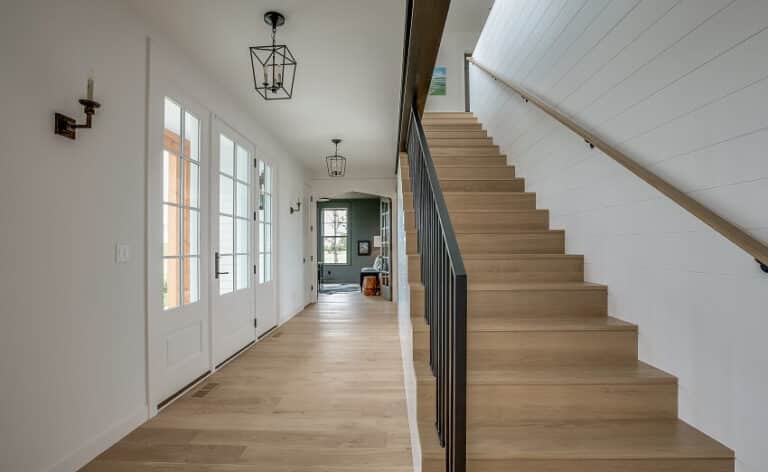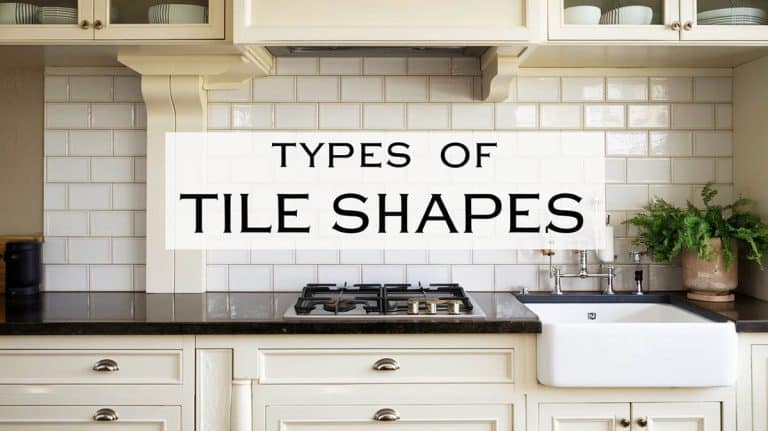21 Ceiling Texture Types (Pattern Design Ideas)
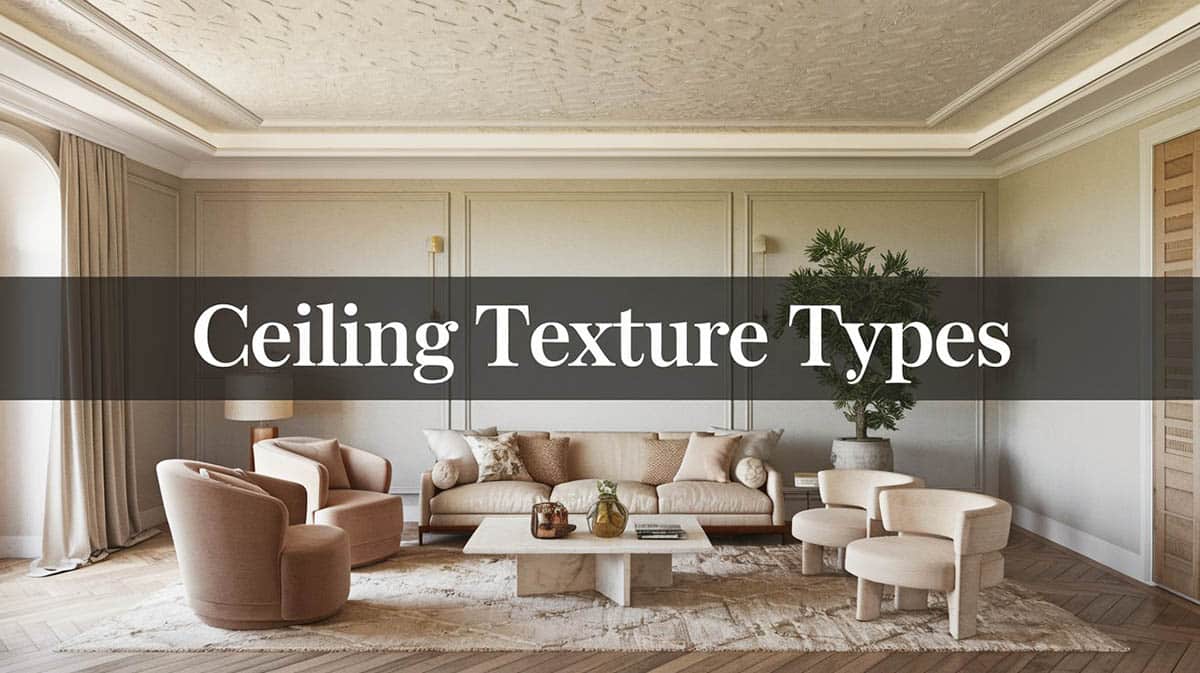
When designing rooms in your home, ideas like the paint color for the walls and ceiling are among the basics. Yet, to create something truly interesting, it’s a good idea to think back further to the fundamentals. In other words, before deciding on the color of your room, try thinking about the ceiling texture patterns you want.
There are many different textures that you can choose from, and they’re a great way to bring another dimension to your interior design.
Knockdown Texture
A knockdown ceiling texture takes a little work to install. You must wait for a ceiling compound to be skinned over and then flatten it with a specialty tool. This second step is known as “knocking down,” hence the application’s name. Once the material is set, the only thing left is to prime and paint the ceiling. While it’s difficult to install and repair, knockdown finishes have a popular appearance, and they cover imperfections well. Despite the number of steps it takes to set it up, it isn’t a particularly difficult installation.
Popcorn Texture
Popcorn ceiling texture peaked in the late 20th century, but it still holds sway in many homes. The application is achieved by using a mix of compound and styrofoam balls. To install it, a hopper and gun are used without complicated tooling. You also don’t need to worry about painting it, and it’s easy to handle during repairs and remodels. The downside is that the gun and hopper leave some mess, and you’ll need to hang plastic for the job.
Drywall Texture
Technically, a drywall ceiling texture is an open term. You can use any standard pattern to finish off a plain drywall or plaster area. In addition, it isn’t the plaster or drywall itself being manipulated when textures are added to a ceiling. Instead, a layer of drywall mud is added to the sheetrock, and tools such as trowels, rollers, and sprayers are used to create the textures. Even smooth finish applications tend to add a compound to the bare drywall rather than leaving it as is.
Orange Peel Texture
The orange peel ceiling texture gets its name from the look of the finish, which resembles the inside of the peel of an orange. To get this look, the ceiling is sprayed about 2 to 3 feet away with a mixture using a hopper and gun, much like how a knockdown finish is started. While applying, the hopper gun should continue moving at all times to avoid buildup.
Once the material is set, you can use a drywall knife to break off high spots if desired. The material will take about 24 hours to completely dry before being able to prime and paint. This is an easy choice to tackle during repairs and remodels, and it’ll hide imperfections during the process easily. It’s also a less expensive choice. However, since a spray is used, this can be a messy installation with a bit of cleanup.
Stomp Texture
A stomp texture is a great choice if you want something unique that will easily cover any imperfections in the ceiling’s surface. The stomped look is achieved using a base material made out of drywall joint compound thinned with water to the point that it’s a paint-like consistency. From here, you can use a roller and stomp brush to set the pattern into the ceiling. This pattern isn’t necessarily difficult to pull off, but you’ll want to take measures such as putting down plastic to counteract the mess.
Rosebud Texture
A rosebud texture is a very easy finish to apply to your ceiling if you know what to do. It only takes a thin layer of mud to pull off the look, and the finish can be created with either an airless paint sprayer, a stomp brush, or a paint roller. When using a paint roller, it’s advised to use a 3/4-inch nap roller cover. The application of drywall mud should be applied across all of the surfaces. The result is a more subtle consistency, blending seamlessly with smooth walls. The only downside is that a thin layer of mud isn’t as effective as a thick one in accounting for imperfections.
Sand Texture
The sand, or sand spray texture, resembles the orange-peel finish. It gives your home an artistic touch, and it isn’t too difficult to install. The only challenge here is preparation, as you must mix a bag of sand additives with cold water the night before you complete the installation. As long as you remember to take this step, the actual installation is a breeze. Since this is a heavily textured pattern with no set composition, it hides any inconsistencies or blemishes in the process or ceiling well.
Swirl Texture
A swirl ceiling texture gets its name from the circular patterns the style depends on. This is a pretty versatile choice that gives you a few application options. It is very similar to the fish scale design. The technique can be done with a trowel, roller, or sprayer. While it takes patience, the most difficult part of the installation is ensuring you complete the process before the mud dries. While the tedious aspect of the installation is a con to this style, you can make the process much easier by employing a second person to help you.
Fish Scale Texture
A fish scale texture is an eye-catching choice that will look amazing on any ceiling. It uses sweeping, circular arches to create the pattern, and it has the advantage of being attractive while not being one of the most common applications used. This means it’ll give your home a unique characteristic. The fish scale pattern is also called the fan or shell pattern. The only downside is that fish scale finishes have a high difficulty level. It’s one of the options that is best left to a professional installation.
Crows Foot Texture
Crow’s foot ceiling textures resemble a bird walking around on the surface. To achieve this, a stipple brush is used in a process that usually takes two individuals. One installer applies mud to sections, while the other uses the stipple brush to make the pattern before the mud dries. While this can be a messy project, you don’t have to break your back doing it. It’s a fairly easy installation. Just remember to put plastic down to contain the mess.
Smooth Texture
A smooth texture is likely the most popular finish in homes today. It’s exactly what it sounds like – with an even, uninterrupted consistency. While it’s the simplest option, it’s one of the more taxing installations. This is because it takes multiple coats of mud with time taken to sand it down between layers. This takes a lot of skill because any imperfections in the process will be noticeable. Once the application is installed, though, it’s easy to take care of. All you need to do is to prime and paint it to finish it off. Painting it with flat white gives a non-reflective quality that helps the room feel brighter.
Stipple Texture
It takes a bit of technical skill to achieve stipple ceiling textures. It’s installed using a roller and slap brush, but the difficulty comes with the thickness of the material. This consistency can make the remodel a messy job if you aren’t sure exactly how to handle it. This style and material come with significant advantages as well, though. For one, you don’t have to worry about obvious imperfections. Even larger imperfections like holes can be easily covered with this ceiling application. The result is an attractive and popular choice.
Tree Bark Texture
This ceiling texture, as the name suggests, is meant to resemble tree bark. This makes it a good choice for homes drawn from naturally-inspired interior design themes. This is considered a pretty artistic finish, so it’ll draw the eyes up with its distinct appearance. The finish is typically done using a heavy roller. The fact that the roller is heavy is important because this style depends on carefully implemented deeper grooves.
Skip Trowel Texture
The uneven look of a skip trowel ceiling is created by dragging a trowel along the surface as an all-purpose joint compound is drying. This is generally done lightly with a more uneven pressure on the final pass to give an uneven look. This is an advantageous design because it works well at hiding any imperfections you might have in your room. Unfortunately, it’s also a difficult choice for any repairs you need later.
Skim Coat Texture
A skim coat ceiling texture is a type of smooth finish. It’s a nearly even surface with slightly raised areas. It doesn’t hold any specific pattern, but since it isn’t completely flat, it’s a little more forgiving when showing imperfections than a completely smooth composition. This makes it a good choice to cover previously heavily textured areas. This design does have some of the same installation challenges as a smooth finish, such as the use of multiple layers of mud.
Lace Texture
A lace ceiling texture is one of the most distinctive design choices. It copies the delicate designs of lace and lays them as a pattern. This makes it a great choice to complement older homes with traditional styles. This is also a good style for homes with a tray ceilings that will give your design a one-of-a-kind look. This is an intensive installation process that takes a lot of skill and tools. Because of this and the generally unforgiving nature of the design, it’s best to hire a professional to create this look.
Slap Brush Texture
The largest drawback to the slap brush ceiling application is that it isn’t an easy installation. The good news is that once this challenging installation is finished, you’ll have a gorgeous and artistic touch to your home. To start, cover the area with the mud with a roller. Now, take a stiff bristle brush and use it to slap the surface to create the finish. This is the difficult part because any mistakes and imperfections in the process are going to be fairly visible and can give you a messy finish.
Unaggregated Texture
An unaggregated ceiling texture is another material rather than a specific application technique. It’s made to handle a wide variety of finish designs, whether mild or fairly bold. It is typically applied either by hand or as a spray-on application. It can create popular patterns such as knockdown, spatter, and orange peel. This makes unaggregated mixtures a rather versatile choice regarding the material for your new finish or repairs.
Artex Texture
Artex refers to a branded material used in ceiling textures rather than just a special pattern. It’s meant to help homeowners obtain a patterned surface without having to call in plastering skills. It was initially high in popularity during the 1970s, especially in Britain. Today, though, the material has fallen out of mainstream use. The main reason the material isn’t as popular anymore is because it’s very difficult to repair and remove. It was the potentially marred appearance of earlier repairs that damaged its credibility.
Homax Popcorn Texture
Homax Popcorn Textures is a non-asbestos-based spray that is made to help you get your ceiling ready to finish. This is a newer and more commonly used material than Artex. Artex does have an advantage when it comes to versatility. The Homax Popcorn Sprays are, as their name suggests, made with popcorn applications in mind. This material is also versatile because it comes in different colors. This helps consolidate installation and painting.
Santa Fe Texture
A Santa Fe ceiling texture is an offshoot of the drywall finish. It also holds similarities to the skip trowel design but differs in that it has smoother areas in its implementation. A good general rule of thumb is that if the application offers more than 60% coverage for your ceiling, it’s a Santa Fe finish. Less than 60% still fall in the skip trowel category. Since this is still an uneven application, it will help hide imperfections. However, it may not do so as well as a highly textured choice.
Most Popular Textures for the Ceiling
When it comes down to it, the most popular ceiling textures include skip troweling, knockdown, popcorn, orange peel, and smooth finish. These commonly used processes have advantages and disadvantages that we’ve already touched on.
Best Texture to Use
The best is a relative title. What works for one home might not fit another. However, lace patterns are often considered the most unique and beautiful options.
Cost to Texture the Ceiling
This number depends on a few factors. Mainly, the type you use will make a difference. Difficult choices such as lace applications will cost more than, for example, a stipple finish. The exact cost varies quite a bit. The average hovers around $.46 to $.62 per square foot, while more intensive choices like smooth applications can cost up to $2 or more per square foot.
Texture FAQs
Below, we try to answer the most frequently asked questions regarding texturing your interior.
How Do You Match an Existing Texture to the Ceiling?
To match an existing ceiling texture, you must first determine the current application and how it’s achieved. Then, it’s a good idea to test out a small surface area to ensure you know how to do it. For more complicated designs, it can be a good idea to contact professional help. The hardest part is matching colors. After all, you’re putting up fresh material next to material fading over the years.
For this step, paint will be your best friend. There is no secret regarding matching what you already have, and it will require you to experiment carefully. One thing to remember when applying is that if you don’t get the look right, you can gently wipe it off right away with a wet sponge to try again.
For a seamless look, you can match the wall texture with the ceiling. If you have low overhead space, a more subtle pattern is recommended. Also, remember that a deep grooved depth design can be harder to keep clean and collect dust and debris. This can add more maintenance in a space such as the kitchen, where cooking grease can accumulate.
Are Textures on the Ceilings Outdated?
Textures on ceilings aren’t a modern idea, but that doesn’t necessarily mean they’re outdated. Since there are so many different options you can use, it’s hard to say that all of them are outdated. That said, certain patterns aren’t as widely appreciated as they once were. For example, many homeowners prefer alternatives to popcorn because they were widely used between the 1950s and 1980s and are considered outdated.
Many of these finishes are still used in residential construction, while popcorn applications are out of style for most people. For rooms with higher overheads, a design can offer visual interest and the experience of being in a luxurious setting. Smaller spaces may benefit from a toned-down appearance not to be overwhelming.
Popcorn Vs. Textured Ceiling
Technically, there is a difference between popcorn and an (acoustic) textured ceiling. The main difference is that the popcorn surfaces are not achieved by stamping or shaping mud but by introducing a foreign ingredient, such as styrofoam balls, to create the pattern. Popcorn surfaces can be textured over, but the job isn’t always easy. Your most affordable choice is to seal the material with a heavier application in another style, or you can trowel it.
The best way to remove the popcorn for retexturing is to mist the area with a garden pump sprayer, letting it soak for approximately 15 minutes before scraping the material away. Be careful not to over-spray the roof interior, as doing so may damage the drywall underneath.

